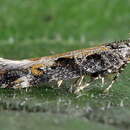pms
nòm ant ël fil


Aristotelia subdecurtella, the brown fen neb, is a moth of the family Gelechiidae. It is found in most of Europe, except Norway, Belgium, Spain, Switzerland, the Czech Republic and most of the Balkan Peninsula.[1] It is also found in the Russian Far East.[2] The habitat consists of wetland areas.
The wingspan is 12–13 mm.[3] Adults have been recorded on wing from late June to August.
The larvae feed on Lythrum salicaria and Stachys palustris.[4] They live between shoots spun together with silk.[5]
Aristotelia subdecurtella, the brown fen neb, is a moth of the family Gelechiidae. It is found in most of Europe, except Norway, Belgium, Spain, Switzerland, the Czech Republic and most of the Balkan Peninsula. It is also found in the Russian Far East. The habitat consists of wetland areas.
The wingspan is 12–13 mm. Adults have been recorded on wing from late June to August.
The larvae feed on Lythrum salicaria and Stachys palustris. They live between shoots spun together with silk.
De pistoolmot (Aristotelia subdecurtella) is een vlinder uit de familie tastermotten (Gelechiidae). De wetenschappelijke naam is voor het eerst geldig gepubliceerd in 1859 door Stainton.[1]
De soort komt voor in Europa.
Bronnen, noten en/of referentiesDe pistoolmot (Aristotelia subdecurtella) is een vlinder uit de familie tastermotten (Gelechiidae). De wetenschappelijke naam is voor het eerst geldig gepubliceerd in 1859 door Stainton.
De soort komt voor in Europa.
Bronnen, noten en/of referenties Taxonomische informatie over Aristotelia subdecurtella bij Fauna Europaea.Aristotelia subdecurtella é uma espécie de insetos lepidópteros, mais especificamente de traças, pertencente à família Gelechiidae.[1]
A autoridade científica da espécie é Henry Tibbats Stainton, tendo sido descrita no ano de 1859.
Trata-se de uma espécie presente no território português.
Aristotelia subdecurtella é uma espécie de insetos lepidópteros, mais especificamente de traças, pertencente à família Gelechiidae.
A autoridade científica da espécie é Henry Tibbats Stainton, tendo sido descrita no ano de 1859.
Trata-se de uma espécie presente no território português.